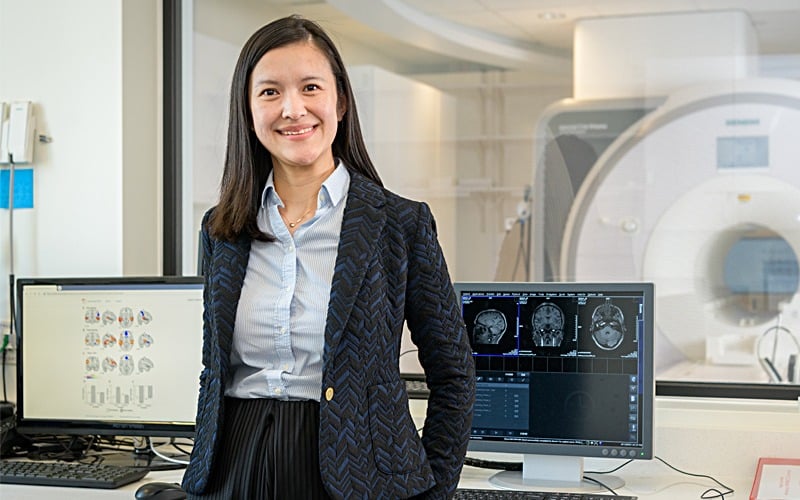 Research & Discovery
Research & Discovery
A Blog Devoted to UD Innovation, Excellence and Scholarship
Research & Discovery
A Blog Devoted to UD Innovation, Excellence and Scholarship
Learning language
ABOVE: Zhenghan Qi and colleagues used a functional MRI instrument, like this one in UD’s Center for Biomedical and Brain Imaging, to scan the brains of people who were learning a new language. | Photo by Evan Krape
Research reveals new insights into how brain functions
Learning it in a class that essentially compresses a one-semester college course into a single month of intensive instruction — and agreeing to have your brain scanned before and after—might seem even more daunting.
But the 24 Americans who did just that have enabled University of Delaware cognitive neuroscientist Zhenghan Qi and her colleagues to make new discoveries about how adults learn a foreign language.
The study, published in May in the journal NeuroImage, focused on the roles of the brain’s left and right hemispheres in language acquisition. The findings could lead to instructional methods that potentially improve students’ success in learning a new language.
“The left hemisphere is known as the language-learning part of the brain, but we found that it was the right hemisphere that determined the eventual success” in learning Mandarin, said Qi, assistant professor of linguistics and cognitive science.
“This was new,” she said. “For decades, everyone has focused on the left hemisphere, and the right hemisphere has been largely overlooked.”
The left hemisphere is undoubtedly important in language learning, Qi said, noting that clinical research on individuals with speech disorders has indicated that the left side of the brain is in many ways the hub of language processing.
But, she said, before any individuals — infants learning their native language or adults learning a second language — begin processing such aspects of the new language as vocabulary and grammar, they must first learn to identify its basic sounds or phonological elements.
It’s during that process of distinguishing “acoustic details” of sounds where the right side of the brain is key, according to the new findings.
Researchers began by exposing the 24 participants in the study to pairs of sounds that were similar but began with different consonants, such as “bah” and “nah,” and having them describe the tones, Qi said.
“We asked: Were the tones of those two sounds similar or different?” she said. “We used the brain activation patterns during this task to predict who would be the most successful learners” of the new language.
The study continued by teaching the participants in a setting designed to replicate a college language class, although the usual semester was condensed into four weeks of instruction. Students attended class for three and a half hours a day, five days a week, completed homework assignments and took tests.
“Our research is the first to look at attainment and long-term retention of real-world language learned in a classroom setting, which is how most people learn a new language,” Qi said.
By scanning each participant’s brain with functional MRI (magnetic resonance imaging) at the beginning and end of the project, the scientists were able to see which part of the brain was most engaged while processing basic sound elements in Mandarin. To their surprise, they found that — although, as expected, the left hemisphere showed a substantial increase of activation later in the learning process — the right hemisphere in the most successful learners was most active in the early, sound-recognition stage.





